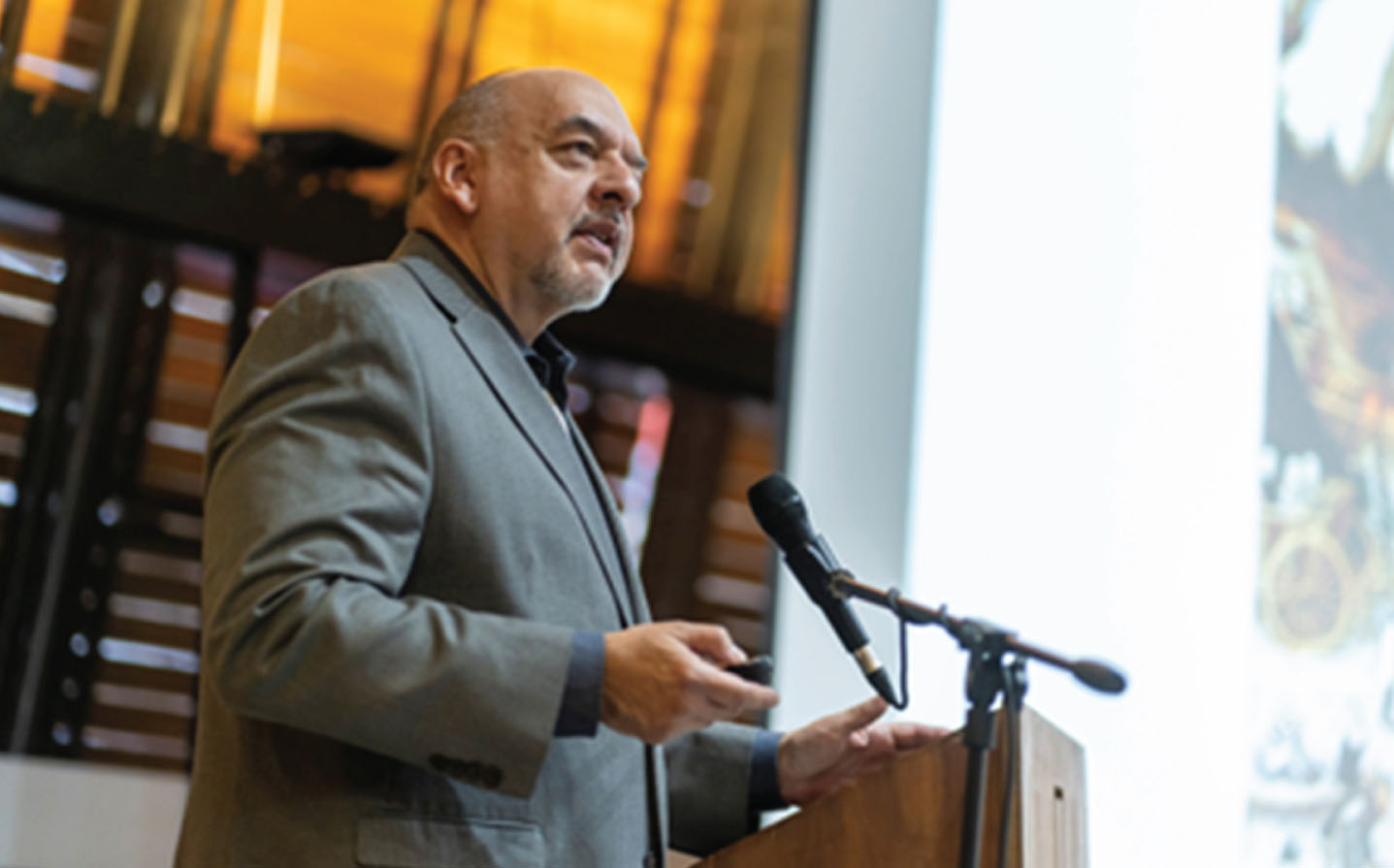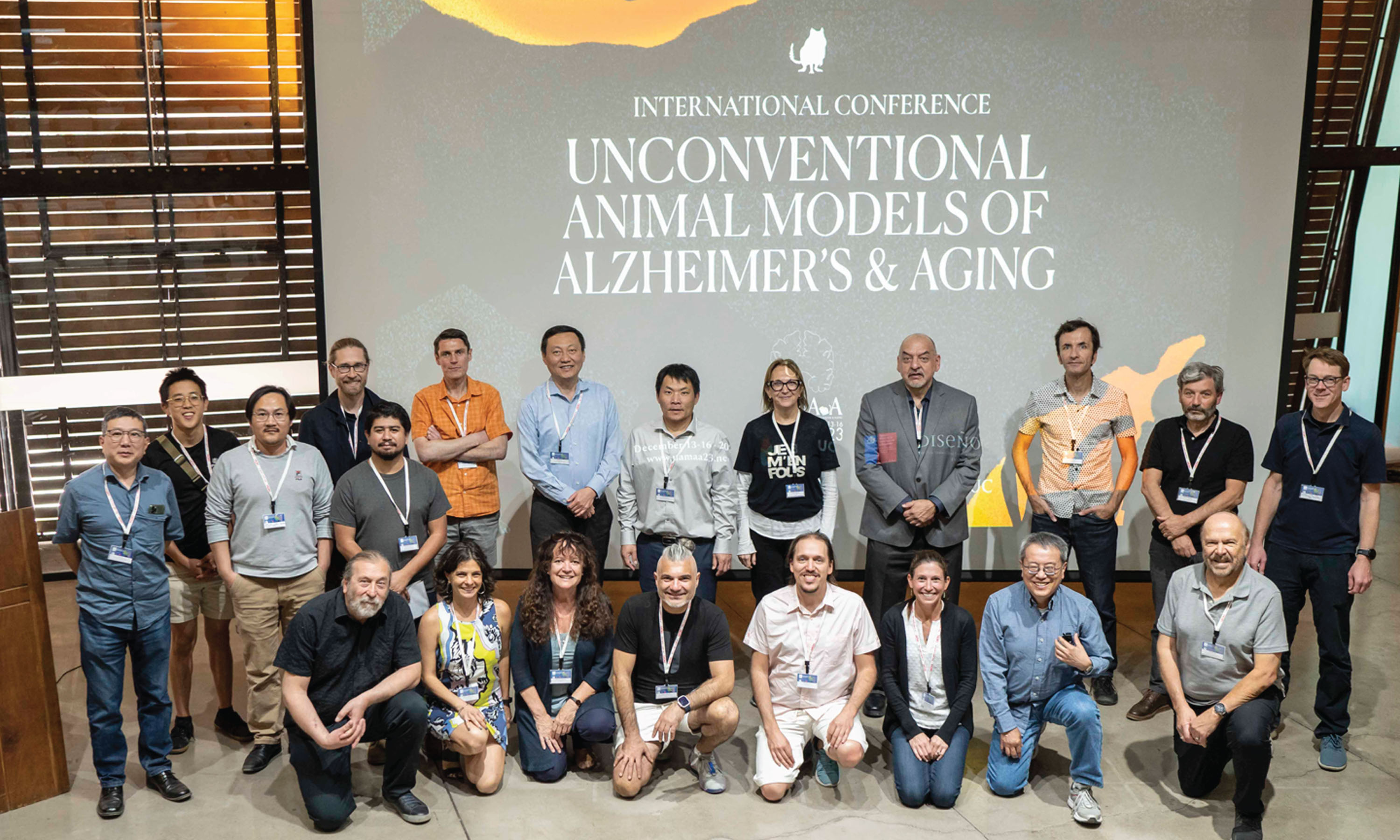First International Conference on Unconventional Animal Models of Alzheimer’s Disease and Aging
Abstract
The first International Conference on Unconventional Animal Models of Alzheimer’s Disease and Aging (UAMAA) took place on December 13–16, 2023, in Santiago, Chile. The Alzheimer’s disease (AD) research field is currently in search for new and unconventional models that could hold greater translational potential than transgenic mouse models. Thus this UAMAA conference is timely and significant. The event consisted of 6 sessions with talks from 28 world-class scientists from all over the world. These animal models of interest include the degu (Octodon degu), the dog (Canis familiaris), and certain species of nonhuman primates that may better recapitulate neuropathology and cognitive impairments in human AD. Our conference has provided a formal forum to discuss and highlight new research directions, alternative animal models, and innovative approaches for the AD and aging research field.
The first International Conference on Unconventional Animal Models of Alzheimer’s Disease and Aging (UAMAA) was held on December 13–16, 2023, in Santiago, Chile. The conference was timely and significant as it highlighted new research directions, alternative animal models, and innovative approaches. Currently most Alzheimer’s disease (AD) animal models are transgenic mice; while they have provided important insights into the disease, the translation of AD mouse model findings to clinic applications has been limited. Thus, there have been recent efforts, including those from the NIH’s National Institute on Aging, to support the development, characterization, and validation of new or unconventional mammalian, non-murine, models of AD that may have improved translational potentials (also see https://grants.nih.gov/grants/guide/rfa-files/rfa-ag-21-003.html) [1–3]. These models including the degu (Octodon degu), the dog (Canis familiaris), and certain species of nonhuman primates (NHP) that may better recapitulate neuropathology and cognitive impairments that are directly associated with the aging process. The new or unconventional models of interest are expected to contribute to a better understanding of AD mechanisms and the development of new therapeutics for AD.
Our conference took place in the beautiful School of Design in the Pontifical Catholic University of Chile. It brought together a strong multidisciplinary group of neuroscientists, molecular biologists, geneticists, and bioinformatics experts to cover recent advances in the understanding of AD and aging and discuss new technologies and unconventional animals that naturally develop the disease. Speakers and attendees included Joseph Ecker, Director of Genomic Analysis Laboratory and Howard Hughes Medical Institute Investigator at the Salk Institute for Biological Studies in La Jolla, California, Xiangmin Xu, Director of the Center for Neural Circuit Mapping at the University of California, Irvine (UCI), Bing Ren, Director of the Center for Epigenomics and Ludwig Institute for Cancer Research Investigator at the University of California, San Diego (UCSD) and Chilean investigators such as Patricia Cogram, Associate Professor at ISEB of University of Chile, and Adrian Palacios, Professor at the University of Valparaiso, as well as special representatives from the Allen Institute of Brain Science and the National Institute on Aging (Figs. 1 and 2).
Fig. 1
Dr. Manuel Moro from the National Institute on Aging delivered a keynote address on the unconventional animal Models of Alzheimer's disease at the 20203 UAMAA Conference.

Fig. 2
Conference group photograph of most speakers and special guests. Top from left to right, include (1) Li Zhang, (2) Jeffrey Chiu, (3) Wei Xu, (4) Trygve Bakken, (5) Pedro Fernandez, (6) Ewan St. John Smith, (7) Bing Ren, (8) Xiangmin Xu, (9) Patricia Cogram, (10) Manuel Moro, (11) Claudio Hetz, (12) Adrian Palacios, and (13) Gregory Carter. Bottom from left to right (14) Jorge M. Podozis, (15) Noelia Weisstaub, (16) Margarita Behrens, (17) Andreas S. Tolias, (18) Emilio Kropff, (19) Stephanie McGrath, (20) Kuo-Fen Lee, and (21) Joseph Ecker. The speakers missing from the photo include: Max Garduño, Mariano Gabitto, Douglas Nitz, Michael Koob, Kevin Beier, Kalpna Gupta, and Qiao Ye. Photographed by Pablo Rojas.

Our conference had six sessions with exciting topics discussed by 28 world-class scientists. Wednesday, December 13 started things off with an afternoon session (Session 1) that included talks from Maximiliano Garduño from UCI (“Apoe variants in the Octodon Degus and their correlation with Alzheimer’s disease-like neuropathology”), Jeffrey Chiu from UCSD (“Multi-modal single-cell characterization of Alzheimer’s disease pathology in dogs”), and Mariano Gabitto from the Allen Institute (“Seattle Alzheimer’s Disease Atlas (SEA-AD) aiming to characterize the neuropathological, molecular, and spatial changes taking place in AD”).
Thursday, December 14 began with a morning session (Session 2) with talks from Kevin Beier from UCI (“Identification of prodromal neural circuit changes driving AD pathogenesis”), Stephanie McGrath from Colorado State University (“Developing the privately owned companion dog as a model for Alzheimer’s disease”), Margarita Behrens from the Salk Institute (“Individual variability in human neuronal-type transcriptomes and epigenomes during aging”) and Andreas Tolias from Baylor College of Medicine (“Deciphering the neocortical blueprint: Implications for aging and neurodegeneration”). This was followed by an afternoon session (Session 3) with presentations from Gregory Carter from Jackson Laboratory (“Multi-omics analysis of a genetically engineered marmoset model of Alzheimer’s disease”), Kuo-Fen Lee from the Salk Institute (“How to live longer lives by escaping Alzheimer’s disease: Comparative and functional genomics toward modelling in marmosets”), Kalpna Gupta from UCI (“Gait modulation in aging”), Emlio Kropff from the Leloir Institute (“Spatial maps and oscillations in the healthy hippocampus of Octodon degus”) and Joseph Ecker from the Salk Institute (“Epigenome erosion in Alzheimer’s disease”).
Friday, the morning session of December 15 (Session 4) consisted of talks from Trygve Bakken from the Allen Institute (“Evolutionary specialization and vulnerability of human cortical cells”), Douglas Nitz from UCSD (“Circuitry and dynamics of spatial tunign at the cortico-hippocampal juncture in Alzheimer’s Disease mouse models”), keynote speaker Manuel Moro from the National Institute on Aging (“National Institute on Aging efforts for developing new/unconventional animal models of Alzheimer’s disease”), Xiangmin Xu from UCI (“Single-cell spatial transcriptomic analysis of Alzheimer’s disease pathogenesis in animal models”), and Bing Ren from UCSD (“Comparative single-cell analysis of the gene regulatory programs in the mammalian brain”). Friday afternoon’s session (Session 5) heard talks from Jorge Podozis from the University of Chile (“Octodon degus and its close relatives: a natural experiment on change and conservation of phylogeny”), Patricia Cogram from the University of Chile (“Octodon degus as a model of Alzheimer’s disease”), Noelia Weisstaub from Favaloro University (“Exploring rodent episodic memory: An overview of behavioral assessment”), Ewan St. John Smith from the University of Cambridge (“Healthy ageing with the naked mole-rat: brains, pain and cancer”), Adrian Palacios from the University of Valparaiso (“Electrophysiological studies of aging biomarkers: Using the Octodon Degus retina as a natural model”), and Li Zhang from the University of Southern California (“Sensory circuits for affective and motivational valence processing”).
The conference wrapped up with a final morning session (Session 6) on Saturday, December 16, with talks from Wei Xu from University of Texas Southwestern (“Transneuronal targeting of neurons and astrocytes”), Michael Koob from the University of Minnesota (“Transplanting the genetics of human dementia into mice: Full human replacement mouse models of Alzheimer’s disease gene- and related dementias”), Qiao Ye from UCI (“Hippocampal formation neural circuit connectivity alterations in Alzheimer’s disease mouse models revealed by monosynaptic rabies virus tracing”), and Pedro Fernandez from the University of Chile (“Ontogenetic development of morphometric heterogeneities at the vomeronasal pathways: The social rodent Octodon degus as a case in point”). Details on the topics covered by each speaker from all sessions (1–6) can be found at https://uamaa23.net/.
Our conference brought to the forefront a collection of unconventional animal models that possess great potential as models for AD and aging. The most prominent ones are the degu, the dog, and the marmoset, all of which were showcased in several conference presentations due to their innate characteristics and potential to contribute to the AD research field. These presentations were complemented with the talks on state-of-the-art human AD research to build a multimodal translational context in which these unconventional animal models can be compared and contrasted to. We foresee that the translational potential of new and unconventional AD animal models will lead to the formulation of novel theories and hypothesis, which could guide a better understanding of AD and aging.
The key organizer of this Conference was Dr. Patricia Cogram from the University of Chile. Her research focuses on the study of complex interactions between genetic and epigenetic variations associated with memory deficits in AD and aging processes using the Octodon degus as an experimental model. She was assisted by Dr. Xiangmin Xu from UCI and Dr. Bing Ren from UCSD. The conference was regarded as a great success by the 150 attendees. Given this feedback and continued interest, we are planning our second UAMAA conference in December 2025, tentatively at the University of California, Irvine.
ACKNOWLEDGMENTS
We acknowledge and thank our speakers. We also would like to acknowledge the conference organizers, Patricia Cogram, Xiangmin Xu, Bing Ren and our Center Staff Carolina Mendoza, and Lina Cardenas. We acknowledge the support from the UCI Center for Neural Circuit Mapping, AMO Pharmaceutical, UK and ANID-Fondecyt Chile 1200928.
FUNDING
XX, BR, and PC are supported by the US National Institutes of Health grant (R24 AG073198).
CONFLICT OF INTEREST
The authors have no conflict of interest to report.
REFERENCES
[1] | National Institute on Aging, Seeking alternative animal models for Alzheimer’s disease, https://www.nia.nih.gov/research/blog/2019/04/seeking-alternative-animal-models-alzheimers-disease. |
[2] | Alzheimer’s Association, Alzheimer’s & Dementia Special Issue: Model Organism Development & Evaluation for Late-Onset Alzheimer’s Disease (MODEL-AD), https://alz-journals.onlinelibrary.wiley.com/hub/journal/15525279/homepage/call-for-papers-model-ad. |
[3] | King A ((2018) ) The search for better animal models of Alzheimer’s disease. Nature 559: , S13–S15. |




